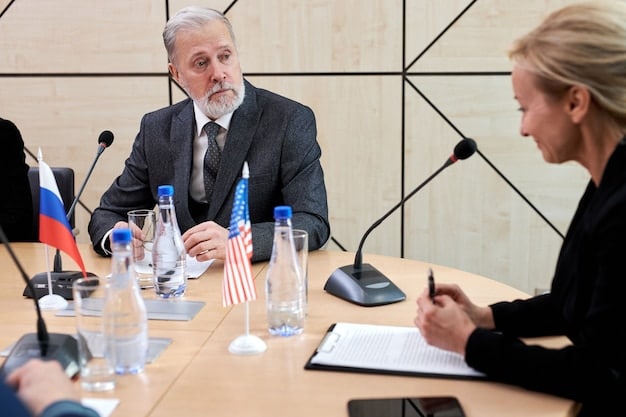The US and NATO in 2025: Future Outlook and Challenges

The US and NATO’s future in 2025 hinges on adapting to evolving geopolitical landscapes, addressing internal challenges, and maintaining transatlantic unity amid emerging threats like Russian aggression and cybersecurity risks.
The relationship between the US and the future of NATO: What to expect in 2025 will be shaped by numerous factors, including domestic political shifts, evolving global threats, and the ongoing debate over burden-sharing within the alliance. The coming year will likely see a continued focus on strengthening NATO’s deterrence capabilities, addressing cybersecurity vulnerabilities, and adapting to new forms of hybrid warfare.
The Evolving Geopolitical Landscape
The geopolitical landscape is constantly shifting, presenting both challenges and opportunities for the US and NATO. Understanding these changes is crucial for anticipating the future direction of the alliance.
Several key trends are shaping the environment in which NATO operates. These include the rise of new global powers, the resurgence of traditional rivals, and the emergence of non-state actors capable of wielding significant influence.
Rising Global Powers and NATO
The ascent of countries like China and India is altering the balance of power, requiring NATO to reassess its strategic priorities. These nations possess growing economic and military clout, influencing global trade, security, and diplomatic relations.
Russia’s Resurgence
Russia’s increasingly assertive foreign policy, including its actions in Ukraine and Syria, poses a direct challenge to NATO’s security. This has led to a renewed focus on deterrence and defense capabilities along NATO’s eastern flank.

These geopolitical shifts necessitate a proactive and adaptable approach from the US and NATO, ensuring the alliance remains relevant and effective in safeguarding its members’ interests.
US Domestic Politics and NATO
Domestic political dynamics within the United States significantly influence its commitment to and engagement with NATO. Changes in administration, congressional priorities, and public opinion can all affect the US role in the alliance.
Looking ahead to 2025, understanding the potential shifts in US domestic politics is crucial for predicting the future of the US-NATO relationship. Different administrations may have varying approaches to foreign policy and defense spending.
- Presidential Elections: The outcome of the next presidential election could lead to significant changes in US foreign policy and its approach to NATO.
- Congressional Support: Bipartisan support in Congress is essential for maintaining stable funding for NATO and US military commitments in Europe.
- Public Opinion: Shifting public attitudes toward international engagement and defense spending can influence political decisions regarding NATO.
These factors highlight the complex interplay between domestic politics and foreign policy, with the US approach to NATO in 2025 contingent on the prevailing political climate.
NATO’s Internal Challenges
NATO faces several internal challenges that could impact its effectiveness in 2025. These challenges include burden-sharing disputes, diverging strategic priorities among member states, and institutional reforms needed to adapt to modern threats.
Addressing these internal issues is essential for ensuring NATO remains a cohesive and capable alliance. Failure to do so could undermine its ability to respond effectively to future crises.
Burden-Sharing and Defense Spending
The longstanding debate over burden-sharing remains a contentious issue within NATO. The US has consistently called on other member states to increase their defense spending to meet the agreed-upon target of 2% of GDP.
Diverging Strategic Priorities
NATO member states have diverse strategic priorities, reflecting their unique geographic locations, historical experiences, and threat perceptions. Balancing these competing interests requires ongoing dialogue and compromise.

Overcoming these internal challenges is crucial for strengthening NATO’s unity and effectiveness in the years ahead, ensuring the alliance can effectively address emerging security threats.
Emerging Security Threats
NATO must contend with a range of emerging security threats, including cyber warfare, hybrid warfare, and terrorism. These threats require new strategies and capabilities to effectively deter and respond.
The nature of warfare is evolving, with state and non-state actors increasingly employing unconventional tactics to undermine security and stability. NATO must adapt to these changes to remain relevant.
- Cyber Warfare: Cyberattacks pose a significant threat to critical infrastructure, government networks, and military systems.
- Hybrid Warfare: Hybrid tactics combine conventional military force with disinformation campaigns, economic coercion, and political interference.
- Terrorism: Terrorist groups continue to pose a threat to NATO member states, requiring ongoing intelligence sharing and counterterrorism efforts.
Addressing these emerging security threats will require a comprehensive approach, involving investments in new technologies, enhanced intelligence capabilities, and closer coordination among NATO allies.
Transatlantic Relations
The strength of transatlantic relations between the US and Europe is fundamental to NATO’s success. Maintaining strong ties requires addressing political, economic, and security challenges that could strain the relationship.
The future of the US-NATO alliance depends on the ability of both sides to navigate these challenges and find common ground on key issues. A strong transatlantic partnership is essential for addressing shared threats and promoting global stability.
Economic Tensions
Trade disputes and economic competition between the US and Europe can create friction in the transatlantic relationship. Addressing these issues requires open dialogue and a commitment to fair trade practices.
Political Differences
Differences in political perspectives and foreign policy priorities can also strain transatlantic relations. Maintaining strong ties requires mutual respect and a willingness to compromise.
Strengthening transatlantic relations will require sustained efforts on both sides of the Atlantic to promote mutual understanding, address shared challenges, and reaffirm the commitment to collective security.
NATO’s Adaptation and Modernization
NATO must continue to adapt and modernize its capabilities to remain relevant in a rapidly changing security environment. This includes investing in new technologies, reforming its organizational structure, and enhancing its partnerships with other countries and organizations.
The alliance’s ability to adapt and modernize will be crucial for maintaining its effectiveness in the face of emerging threats and evolving geopolitical realities.
Technological Innovation
Investing in cutting-edge technologies, such as artificial intelligence, autonomous systems, and cyber defense capabilities, is essential for maintaining a military advantage.
Organizational Reforms
Reforming NATO’s organizational structure can improve its agility and responsiveness to emerging crises. This includes streamlining decision-making processes and enhancing coordination among member states.
By embracing innovation and pursuing reforms, NATO can position itself to effectively address the challenges of the 21st century and safeguard its members’ security.
| Key Aspect | Brief Description |
|---|---|
| 🌍 Geopolitical Shifts | Rising powers and Russia’s assertiveness reshape NATO’s focus. |
| 💰 Burden Sharing | US calls for increased defense spending by other NATO members. |
| 🛡️ Emerging Threats | Cyber warfare, hybrid tactics, and terrorism demand new strategies. |
| 🤝 Transatlantic Ties | Maintaining strong relations is crucial for NATO’s success. |
Frequently Asked Questions
▼
NATO faces challenges like burden-sharing disputes, adapting to cyber and hybrid warfare, and maintaining transatlantic unity amidst differing political priorities among member states.
▼
US elections, congressional support, and public opinion shifts can significantly influence the US commitment to NATO, affecting funding and strategic priorities for the alliance.
▼
Russia’s assertive foreign policy and military actions prompt NATO to focus on deterrence along its eastern border, adapt to hybrid warfare, and enhance cybersecurity defenses.
▼
NATO can invest in new technologies like AI, streamline decision-making, enhance cyber defense, and strengthen partnerships to address modern security challenges effectively.
▼
Strong US-Europe relations are vital; addressing economic tensions and political differences is crucial for NATO unity, stability, and effectively managing shared security challenges.
Conclusion
As we look toward 2025, the future of the relationship between the US and the future of NATO: What to expect in 2025 will be shaped by how effectively the alliance addresses its internal challenges, adapts to emerging threats, and maintains transatlantic unity. The coming years will be critical for ensuring NATO remains a strong and relevant force for global security and stability.





